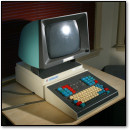 Two teen girls compare notes on vampires that attend their high school.
Two teen girls compare notes on vampires that attend their high school.
Ah, the dedicated electronic pocket organizer — an ever-present, seemingly useful device for want of a market.
Since the early 1980s, electronics manufacturers have produced pocket-sized computer gadgets that store databases of phone numbers, addresses, calendar appointments, and not much else. These electronic organizers reached their peak (in terms of number of devices in the market) in the mid-1990s. At that time, the technology involved became cheap enough to market to kids.
Despite manufacturers’ best efforts, such devices have continuously failed to gain widespread use for a simple reason: none have demonstrably improved upon the paper address book. Not even the socially-hungry teen girl market, as targeted by Sharp in this 1995 ad for the Pocket Locker, could push them into the mainstream.
It was only when manufacturers rolled electronic organizer functionality into a more general-purpose device (think palmtop computer, PalmPilot) that the idea of electronically maintaining personal contact records in a mobile setting took off. Address books, calendars, and phone databases became separate programs that lived in a larger ecosystem of applications that could be run on the device.
Most palmtop computer-style PDAs offered significant advantages over the paper organizer. They synchronized with PCs to back up information, and they could use the stored data in conjunction with other programs for more useful effect — for example, you could actually email someone directly from a record stored in your digital address book.
Contrast that experience to the dedicated pocket organizer model, where the the information you entered became trapped in a tiny plastic box with a crummy display and a kludgy interface that would lose its memory if its batteries ran out.
Today, the organizer-as-software clearly won over dedicated units, and anyone with a mobile phone now carries an organizer software suite in their pocket. It’s only one of many functions that cellphones have absorbed on their quest to become the ultimate multipurpose pocket device.
[ From Pop-Sci For Kids, September-October 1995, back cover ]
Discussion Topic of the Week: Have you ever used a dedicated electronic pocket organizer device? Tell us about it.















